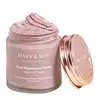What's inside
What's inside
 Key Ingredients
Key Ingredients

 Benefits
Benefits

 Concerns
Concerns

No concerns
 Ingredients Side-by-side
Ingredients Side-by-side

Water
Skin ConditioningDiglycerin
HumectantGlycerin
HumectantKaolin
AbrasiveBentonite
AbsorbentPropanediol
SolventZea Mays Starch
Absorbent1,2-Hexanediol
Skin ConditioningRosa Damascena Flower Water
MaskingPanthenol
Skin ConditioningRosa Gallica Flower Powder
Skin ConditioningXanthan Gum
EmulsifyingAcrylamide/Sodium Acryloyldimethyltaurate Copolymer
Emulsion StabilisingPolyisobutene
Betaine
HumectantButylene Glycol
HumectantParfum
MaskingEthylhexylglycerin
Skin ConditioningDipropylene Glycol
HumectantCI 77491
Cosmetic ColorantDisodium EDTA
Caprylyl/Capryl Glucoside
CleansingSorbitan Oleate
EmulsifyingAllantoin
Skin ConditioningHydrogenated Lecithin
EmulsifyingCentella Asiatica Extract
CleansingFicus Carica Fruit Extract
HumectantCeramide NP
Skin ConditioningSodium Hyaluronate
HumectantTocopherol
AntioxidantHyaluronic Acid
HumectantSodium Hyaluronate Crosspolymer
HumectantHydroxypropyltrimonium Hyaluronate
Sodium Acetylated Hyaluronate
HumectantWater, Diglycerin, Glycerin, Kaolin, Bentonite, Propanediol, Zea Mays Starch, 1,2-Hexanediol, Rosa Damascena Flower Water, Panthenol, Rosa Gallica Flower Powder, Xanthan Gum, Acrylamide/Sodium Acryloyldimethyltaurate Copolymer, Polyisobutene, Betaine, Butylene Glycol, Parfum, Ethylhexylglycerin, Dipropylene Glycol, CI 77491, Disodium EDTA, Caprylyl/Capryl Glucoside, Sorbitan Oleate, Allantoin, Hydrogenated Lecithin, Centella Asiatica Extract, Ficus Carica Fruit Extract, Ceramide NP, Sodium Hyaluronate, Tocopherol, Hyaluronic Acid, Sodium Hyaluronate Crosspolymer, Hydroxypropyltrimonium Hyaluronate, Sodium Acetylated Hyaluronate
Rosa Damascena Flower Water
MaskingGlycerin
HumectantWater
Skin ConditioningMethylpropanediol
SolventBetaine
Humectant1,2-Hexanediol
Skin ConditioningSodium Hyaluronate
HumectantTrehalose
HumectantDextrin
AbsorbentRosa Gallica Flower Powder
Skin ConditioningGlyceryl Polymethacrylate
Glycine
BufferingSerine
MaskingSodium PCA
HumectantSorbitol
HumectantAlanine
MaskingArginine
MaskingThreonine
Proline
Skin ConditioningGlutamic Acid
HumectantLysine
Skin ConditioningRosa Canina Fruit Oil
EmollientPhellodendron Amurense Bark Extract
Skin ConditioningTheobroma Cacao Seed Extract
AntioxidantPolyglyceryl-10 Laurate
Skin ConditioningGeranium Maculatum Oil
MaskingTromethamine
BufferingXanthan Gum
EmulsifyingCarbomer
Emulsion StabilisingEthylhexylglycerin
Skin ConditioningDisodium EDTA
Rosa Damascena Flower Water, Glycerin, Water, Methylpropanediol, Betaine, 1,2-Hexanediol, Sodium Hyaluronate, Trehalose, Dextrin, Rosa Gallica Flower Powder, Glyceryl Polymethacrylate, Glycine, Serine, Sodium PCA, Sorbitol, Alanine, Arginine, Threonine, Proline, Glutamic Acid, Lysine, Rosa Canina Fruit Oil, Phellodendron Amurense Bark Extract, Theobroma Cacao Seed Extract, Polyglyceryl-10 Laurate, Geranium Maculatum Oil, Tromethamine, Xanthan Gum, Carbomer, Ethylhexylglycerin, Disodium EDTA
 Reviews
Reviews

Ingredients Explained
These ingredients are found in both products.
Ingredients higher up in an ingredient list are typically present in a larger amount.
1,2-Hexanediol is a synthetic liquid and another multi-functional powerhouse.
It is a:
- Humectant, drawing moisture into the skin
- Emollient, helping to soften skin
- Solvent, dispersing and stabilizing formulas
- Preservative booster, enhancing the antimicrobial activity of other preservatives
Betaine is a common humectant (a substance that promotes retention of moisture). It's known to be gentle on the skin and can help balance hydration.
This ingredient is best for improving hydration and soothing irritated skin. Studies also show it helps even out skin tone.
Fun fact: Betaine is naturally created in the skin and body. The kind found within cosmetic products can be either plant-derived or synthetic.
Another name for betaine is trimethylglycine.
Learn more about BetaineDisodium EDTA plays a role in making products more stable by aiding other preservatives.
It is a chelating agent, meaning it neutralizes metal ions that may be found in a product.
Disodium EDTA is a salt of edetic acid and is found to be safe in cosmetic ingredients.
Learn more about Disodium EDTAEthylhexylglycerin (we can't pronounce this either) is commonly used as a preservative and skin softener. It is derived from glyceryl.
You might see Ethylhexylglycerin often paired with other preservatives such as phenoxyethanol. Ethylhexylglycerin has been found to increase the effectiveness of these other preservatives.
Glycerin is already naturally found in your skin. It helps moisturize and protect your skin.
A study from 2016 found glycerin to be more effective as a humectant than AHAs and hyaluronic acid.
As a humectant, it helps the skin stay hydrated by pulling moisture to your skin. The low molecular weight of glycerin allows it to pull moisture into the deeper layers of your skin.
Hydrated skin improves your skin barrier; Your skin barrier helps protect against irritants and bacteria.
Glycerin has also been found to have antimicrobial and antiviral properties. Due to these properties, glycerin is often used in wound and burn treatments.
In cosmetics, glycerin is usually derived from plants such as soybean or palm. However, it can also be sourced from animals, such as tallow or animal fat.
This ingredient is organic, colorless, odorless, and non-toxic.
Glycerin is the name for this ingredient in American English. British English uses Glycerol/Glycerine.
Learn more about GlycerinRosa Damascena Flower Water comes from the Damask rose. It is a dilluted version of the Rose Essential oil.
The Damask Roses' petals have antioxidant, antimicrobial, and fragrance compounds. Though antioxidants are great for soothing skin, the fragrance compounds can irritate it.
We don't have a description for Rosa Gallica Flower Powder yet.
Sodium Hyaluronate is hyaluronic acid's salt form. It is commonly derived from the sodium salt of hyaluronic acid.
Like hyaluronic acid, it is great at holding water and acts as a humectant. This makes it a great skin hydrating ingredient.
Sodium Hyaluronate is naturally occurring in our bodies and is mostly found in eye fluid and joints.
These are some other common types of Hyaluronic Acid:
Learn more about Sodium HyaluronateWater. It's the most common cosmetic ingredient of all. You'll usually see it at the top of ingredient lists, meaning that it makes up the largest part of the product.
So why is it so popular? Water most often acts as a solvent - this means that it helps dissolve other ingredients into the formulation.
You'll also recognize water as that liquid we all need to stay alive. If you see this, drink a glass of water. Stay hydrated!
Learn more about WaterXanthan gum is used as a stabilizer and thickener within cosmetic products. It helps give products a sticky, thick feeling - preventing them from being too runny.
On the technical side of things, xanthan gum is a polysaccharide - a combination consisting of multiple sugar molecules bonded together.
Xanthan gum is a pretty common and great ingredient. It is a natural, non-toxic, non-irritating ingredient that is also commonly used in food products.
Learn more about Xanthan Gum